POSITION
Roses need sun, shelter, fresh air and free draining, deep soil. They do not like waterlogged soil, shallow chalk nor being too exposed or too enclosed. If your soil is chalky and shallow dig the area where you want to plant the rose thoroughly and mix in compost as you go. This may mean that you have to dig into chalk, but if you can improve the soil as deeply as possible (60cm down) this will really help the rose grow well. Some roses are more tolerant of chalk, including the Hybrid Musks, Albas and Damask roses. It is useful to add a mycorrhizal feed to the hole before planting. This helps protect against disease and encourages growth.
PREPERATION
Water the plant well at least an hour before planting. Dig a hole 15-20cm bigger all round than the pot, loosen the soil around the edges so that the roots can grow. You can improve the soil around the plant when you put it in by adding a mixture of composted bark, compost and rose food (if planting in spring or summer).
PLANTING
- Miniatures: 30 cm
- Patio: 45-60 cm
- Shrub: 1.5m
- Hybrid Tea and Floribunda: 45-60cm
- Climbers/Ramblers: 3m (30-45cm from wall)
- Standards: 1.5m
GENERAL CARE
Clear away all dead leaves and flowers from around the plant as these will harbour fungal diseases like black spot. Mulch around the rose with about 5 – 7.5 cm depth of bark to help suppress weeds and retain moisture. Remove suckers when they appear. These are growths that come from underground rather than from the plants stem. They must be pulled off rather than cut or they may reappear. Follow them to the base and pull sharply. They are often caused by damage to the roots so take care when hoeing or digging around the plant. Deadheading should be carried out regularly to encourage more flowers. Don’t dead-head those that you are growing for ornamental hips in the winter.
PRUNING
Hybrid Tea and Floribundas
- Newly planted: cut back to 3 – 5 buds. Leave standards slightly longer. Routine pruning should be carried out in early spring when the leaf buds are just beginning to swell.
- Hybrid Tea: remove dead, diseased and dying wood. Cut out any weak and spindly growth. Cut each stem back to about half its length to an outward facing bud.
- Floribunda: as for Hybrid Tea but cut some of the older stems almost to the ground and leave some of the new ones longer. This will help the plant to flower for longer. Don’t cut back too hard as you will cause the plant to grow unevenly and spoil the shape.
Climbers and Ramblers
- Newly planted: Climbers/Ramblers should be cut back to 45-60cm tall, above an outward facing bud. Tie in securely. Prune Climbers and Ramblers in late summer and early autumn when they have stopped flowering.
- Routine for Climbers: allow to grow for the first few years. Train to produce a framework of growth over the area you want to cover and tie in firmly. In subsequent years cut back the flowering side shoots by about a third each year, and remove dead diseased and weak growth.
- Routine for Ramblers: allow to grow for the first few years. If possible cut back stems that have flowered to the ground to encourage new growth but this is often not possible. They flower on last years growth.
Shrubs, Miniatures, Patio and Ground Cover
- Newly planted: just remove any weak or dead wood.
- Routine: remove dead, damaged and diseased wood, and also any spindly or weak growth and trim to shape. If you plant in summer/autumn, prune in spring. If you plant in spring, prune before planting
CONTAINERS
Roses can be planted in containers, some are more suited to this than others. Patio and miniatures do better in containers than other roses. It is possible to put ramblers or climbers in barrels, but they need a lot of space and trying to re-pot or replenish the compost can be very difficult. Choose a suitable container and crock it well to create good drainage. Use John Innes No.3 which will provide suitable levels of nutrients and won’t break down as quickly as peat based compost. Don’t break up the root ball when planting and make sure that the soil level is the same as the soil mark on the stem. If you are planting a standard rose use a stake as well.
Suitable sizes of pots are as follows:
- Miniature: at least 22.5 cm deep
- Patio: at least 30 cm deep
- Floribunda/Hybrid Tea: at least 37.5 cm deep. Top dress annually and give a foliar feed twice during early summer.
FEEDING
It is important to feed roses regularly to encourage growth, flowering and to make them healthier and less prone to disease. Apply a granular or powder fertilizer in the spring before the leaves are fully open: this should be hoed in carefully so as not to damage the roots. Apply again in June or July, but no later as the soft growth produced will be prone to frost damage. Alternatively you can use a liquid fertilizer once a month from April to July. You can add to this a foliar feed. This should be done every 2 weeks from spring until the end of July.
PESTS
Aphids
Not always just green or black. Use a contact or systemic insecticide: a contact insecticide kills only what it touches whereas a systemic travels through the plant and will kill the insect when it sucks the sap.
Caterpillars
If there are just a few, wipe off. If there are too many, remove the froth with a water spray and
then use an insecticide.
Leaf-rolling sawfly
Tightly rolled leaves containing a small grub. Squash the insect in the leaf, pick off and burn the leaves. Can use an insecticide to prevent in May.
DISEASES
Black spot
A fungal disease that is worse in warm, wet summers. Black spots with yellow fringes appear on the leaves and spread to leaves and stems. The leaves then fall. To prevent black spot it is necessary to spray before it appears. Always remove and burn affected leaves to prevent the infection passing on.
Mildew
White powdery mould, worse in late summer in dry airless conditions. Spray weekly with a fungicide to control.
Rust
CHOOSING THE RIGHT ROSE
- Climbers and ramblers are suited to vertical spaces such as walls and structures.
- Hybrid tea and floribunda are best suited to borders as a medium height rose.
- Patio roses are best suited to pots and borders but will stay low.
- Ground covers speak for themselves ad are very good for banks and spaces that need minimal maintenance.
- Standard roses can be grown in pots or in the ground and are usually used to state an entrance or give height in a border.
- Old English shrub varieties are some of the largest of the roses and make a very full border. They tend to be very heavily scented and are not for use in pots.








